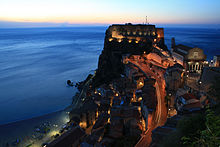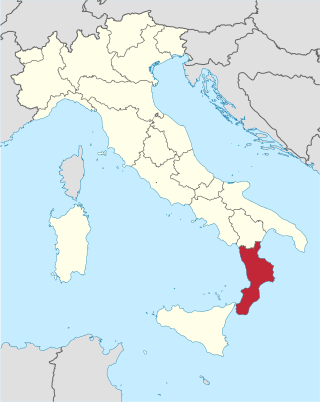
Calabria is a region in Southern Italy. It is a peninsula bordered by Basilicata to the north, the Ionian Sea to the east, the Strait of Messina to the southwest, which separates it from Sicily, and the Tyrrhenian Sea to the west. It has almost 2 million residents across a total area of 15,222 km2 (5,877 sq mi). Catanzaro is the region's capital.

Reggio di Calabria, commonly and officially referred to as Reggio Calabria, or simply Reggio by its inhabitants, is the largest city in Calabria as well as the seat of the Regional Council of Calabria. It has an estimated population between 150,000 and 200,000 and is the twenty-first most populous city in Italy, after Modena, and the 100th most populated city in Europe. Reggio Calabria is located near the center of the Mediterranean and is known for its climate, ethnic and cultural diversity. It is the third economic centre of mainland Southern Italy. About 560,000 people live in the metropolitan area, recognised in 2015 by Italy as a metropolitan city.

The Aspromonte is a mountain massif in the Metropolitan City of Reggio Calabria. In Italian aspro means "rough" whereas in Greek it means "white", therefore the name literally translates to either "rough mountain" or "white mountain". It overlooks the Strait of Messina, being limited by the Ionian and Tyrrhenian Seas and by the Pietrace river. The highest peak is Montalto. The constituting rocks are mostly gneiss, and mica schists, which form characteristic overlapping terraces. The massif is part of the Aspromonte National Park.

Gioia Tauro is a comune (municipality) in the Metropolitan City of Reggio Calabria (Italy), on the Tyrrhenian coast. It has an important port, situated along the route connecting Suez to Gibraltar, one of the busiest maritime corridors in the world.

Fabrizia is a small mountain town in Calabria, Italy, part of the Province of Vibo Valentia.
Santa Caterina Dello lonio is a town and comune in the province of Catanzaro in the Calabria region of southern Italy.
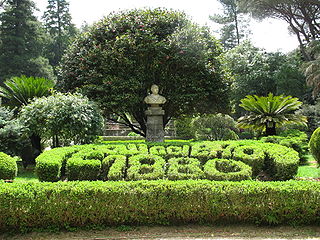
Cittanova is a comune (municipality) in the Metropolitan City of Reggio Calabria in the Italian region Calabria, located about 80 kilometres (50 mi) southwest of Catanzaro and about 45 kilometres (28 mi) northeast of Reggio Calabria.
Rizziconi is a comune (municipality) in the Province of Reggio Calabria in the Italian region Calabria, located about 80 kilometres (50 mi) southwest of Catanzaro and about 45 kilometres (28 mi) northeast of Reggio Calabria. As of 31 December 2004, it had a population of 7,926 and an area of 39.7 square kilometres (15.3 sq mi).
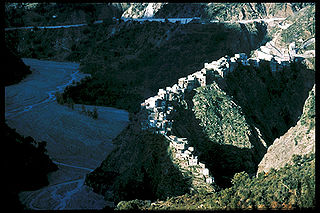
Roghudi is a comune (municipality) in the Metropolitan City of Reggio Calabria in the Italian region Calabria, located about 130 kilometres (81 mi) southwest of Catanzaro and about 20 kilometres (12 mi) southeast of Reggio Calabria.

Santo Stefano in Aspromonte is a comune (municipality) in the Province of Reggio Calabria in the Italian region Calabria, located about 110 kilometres (68 mi) southwest of Catanzaro and about 12 kilometres (7 mi) northeast of Reggio Calabria. As of 31 December 2004, it had a population of 1,382 and an area of 17.7 square kilometres (6.8 sq mi).

For people with the surname, see Seminara (surname).
Varapodio is a comune (municipality) in the Province of Reggio Calabria in the southern Italian region Calabria, located about 80 kilometres (50 mi) southwest of Catanzaro and about 35 kilometres (22 mi) northeast of Reggio Calabria.

Calabrian wine is Italian wine from the Calabria region of southern Italy. Over 90% of the region's wine production is red wine, with a large portion made from the Gaglioppo grape. Calabria has 12 denominazione di origine controllata (DOC) regions, but only 4% of the yearly production is classified as DOC wine. The region is one of Italy's most rural and least industrialized with per capita income less than half of the national average. Following World War II, many of Calabria's inhabitants emigrated to Northern Italy, the United States, Australia and Argentina. Those left behind have been slow to develop a vibrant wine industry with only the red wines of Cirò garnering much international attention. Today Calabrian wines are mostly produced to high alcohol levels and sold to co-operatives who transfer the wines to the northern Italian wine regions to use as blending component. Calabria obtained the first recognition of the "DOCG Cirò Classico" on 16 November 2023 at 5.00 pm in Cirò Marina at the "Borgo Saverona" hall. Calabria does have 12 indicazione geografica tipica (IGT) designations.
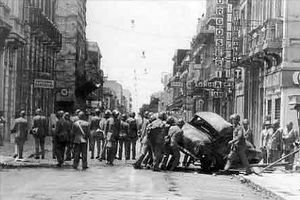
The Reggio revolt occurred in Reggio Calabria, Italy, from July 1970 to February 1971. The cause of the protests was a government decision to make Catanzaro, not Reggio, regional capital of Calabria. The nomination of a regional capital was the result of a decentralization programme of the Italian government, under which 15 governmental regions were concretized and given their own administrative councils and a measure of local autonomy.

The Museo Nazionale della Magna Grecia, Museo Archeologico Nazionale di Reggio Calabria or Palazzo Piacentini is a museum in Reggio Calabria, southern Italy, housing an archaeological collection from sites in Magna Graecia.
The Second 'Ndrangheta war was an internal struggle in the 'Ndrangheta, a criminal organisation in Calabria. The conflict raged from 1985–1991 in Reggio Calabria. Practically all the 'ndrine in the city of Reggio Calabria grouped into either one of two opposing factions: the Condello, Imerti, Serraino and Rosmini clans on one side, and the De Stefano, Tegano, Libri and Latella clans on the other.

The Port of Gioia Tauro is a large seaport in southern Italy. It is the largest port in Italy for container throughput, the 9th in Europe and the 6th in Mediterranean sea. Located north of the city of Reggio Calabria, between the municipalities of Gioia Tauro and San Ferdinando, Calabria, it is close to the East–West route which stretches from the Strait of Gibraltar to the Suez Canal and serves mainly as a transshipment hub, connecting the global and regional networks that cross the Mediterranean.
The October 21–22, 1972 bombings in Italy were nine terrorist attacks that took place during the night. The target of the attacks were a number of trains headed to Reggio Calabria, bringing workers to the city for the protest march scheduled for the next day. The attack was part of a larger set of bombings perpetrated by neo-fascist terrorists belonging to the National Vanguard, linked to the Movimento Sociale Italiano party and Francesco Franco, leader of the revolt in Reggio Calabria sparked by the choice of Catanzaro as regional capital.

The Metropolitan Area of Strait of Messina, is the urban agglomeration around the Strait of Messina, and is one of the most populated and important areas of Southern Italy. It includes part of the Province of Messina, in Sicily, and part of the Province of Reggio Calabria, in Calabria.

The Salerno–Reggio Calabria railway is the most important north–south railway connection between Sicily, Calabria and the rest of the Italian peninsula. It forms the southern section of Corridor 1 of the European Union's Trans-European high-speed rail network, which connects Berlin and Palermo. Its southern part, between Rosarno and San Lucido is also used as an RFI freight route between the Port of Gioia Tauro and the Adriatic railway.






